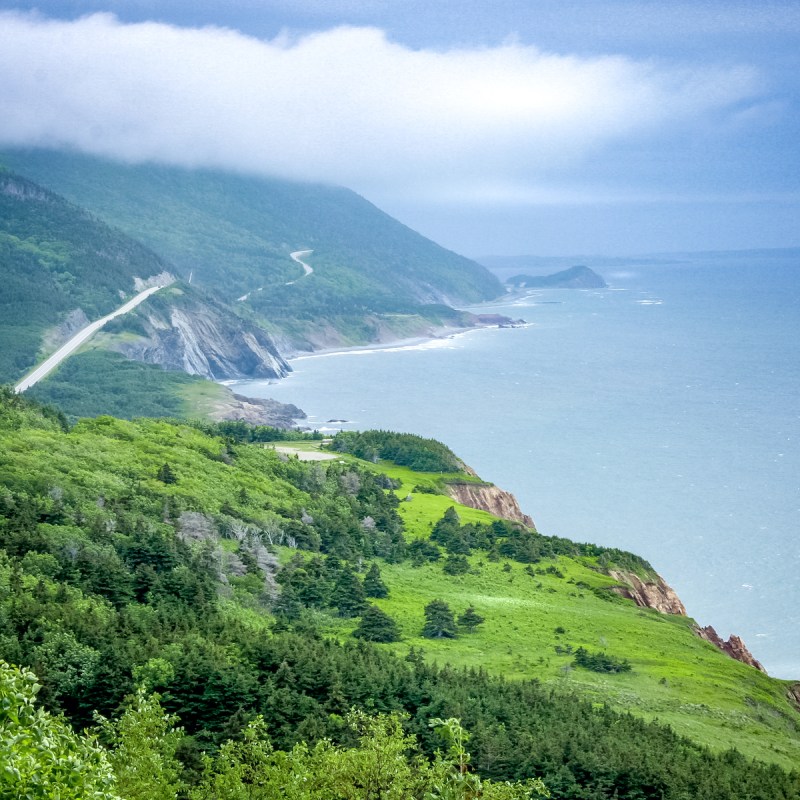
(Pierrette Guertin / Shutterstock.com)
Note: The Travel Awaits team regularly updates content to provide the latest, and most accurate information to our readers. The updated content in this article may not reflect the views or opinions of the original author.
Videos by TravelAwaits

(Kevin Baillie / Shutterstock.com)
A Trip to Nova Scotia and Prince Edward Island – 10 Key Differences
1. Transportation And Getting Around
Nova Scotia is accessible by car, bus, the Via Rail train network, Halifax International Airport (which connects with most major Canadian cities, plus several popular U.S. and European destinations like Boston, Orlando, Frankfurt, Dublin, and London), and via a ferry with links to Maine, Newfoundland, New Brunswick, and Prince Edward Island. With a multitude of transport options, you should check the schedules and the trip cancellation fee.
Within the province, there is basic public transportation through Maritime Bus and some private shuttle services. However, for most trips your own transportation is essential. Nova Scotia is deceptively long, and roads are rarely straight. As a result, visitors often underestimate the amount of time it takes to get to key destinations (like North Sydney, where the Newfoundland ferry departs). Famous scenic drives like the Cabot Trail look like short trips but are day-long excursions.
Prince Edward Island has far fewer transportation options. As it’s an island, visitors must either fly in through Charlottetown or cross the water. The airport currently has flight connections to Halifax Stanfield International Airport and Halifax city and other major eastern Canadian cities like Toronto and Montreal but nothing with the United States or Europe. Those driving can either cross the Confederation Bridge, which links PEI and New Brunswick, or take the ferry.
Ferry reservations are recommended, especially during the busy summer season. Maritime Bus offers limited public transportation options on the island but it’s really designed to link major communities like Summerside and Charlottetown with mainland destinations in New Brunswick.

(Pi-Lens / Shutterstock.com)
2. Geography
PEI is famous for its photogenic red roads (what you’re seeing is the rusty iron oxide) and is generally very flat. On the new Island Walk, a 400+ mile hiking route that circumnavigates the province, there are no slopes greater than a two-degree grade, making it perfect for anyone who wants a gentle trek.
Nova Scotia has a more diverse geography. In particular, the province’s Cape Breton Island is famous for its highlands which resemble those in Scotland. You can expect much more challenging hiking conditions, especially at Cape Breton Highland’s National Park.

(Fanfo / Shutterstock.com)
3. Food And Drink
Nova Scotia and PEI have many culinary similarities. These are meat and potato style destinations, and often that “meat” is actually fish! These are wonderful spots for fresh seafood and shellfish and lobster, haddock, salmon, and trout are widely available.
In Nova Scotia, scallops are a point of local pride, and in the community of Digby, the scallops are often boasted as being the best in the world. Meanwhile, in PEI, oysters are a signature product. They’re transported around the world but happily are often served “buck-a-shuck” style at local restaurants.
While both provinces have French-speaking Acadian populations, their culinary impact is felt more strongly in Nova Scotia, where rappie pie (a local chicken and potato casserole) is popular in the south and chicken fricot (a hearty soup) is common in the north. Meanwhile, Charlottetown, PEI, boasts some of the best Lebanese food in Canada, the legacy of a community that first came to the island in the 1880s to escape religious persecution.
Nova Scotia is justifiably proud of its wine industry, which is fast earning global recognition. PEI’s vineyards are still developing and fruit wines and mead are common.

(Whoever / Shutterstock.com)
4. Arts And Culture
Prince Edward Island boasts some serious literary prowess, as the province was both the early home and long-term inspiration for Lucy Maud Montgomery, author of the Anne of Green Gables series. Anyone who counts themself as a “fan of Anne” will see PEI as a must-visit destination. Anne of Green Gables: The Musical is one of the oldest running theatre productions in Canada and is staged each summer at Charlottetown’s Confederation Center of the Arts.
But while PEI may claim the greatest fame through the Anne series, Nova Scotia has its own literary chops. Some of the biggest names in modern Canadian literature have roots here, and in particular, the province’s Cape Breton Island is particularly notable for its long list of prominent literary award winners. Nova Scotia has the highest number of universities per capita in Canada, and, as such, it rather fancies itself a bit of an intellectual leader (whether or not the rest of the nation feels this way is another thing altogether…).
Both provinces have strong artistic communities. Nova Scotia’s arts scene is generally better known, thanks in large part to the province being the home of folk artist Maud Lewis, whose work continues to gain prominence.

(Howard Sandler / Shutterstock.com)
5. Beaches
If you want gorgeous beaches, you cannot go wrong with Nova Scotia and PEI. They have some of the finest coastal scenery in the world. However, you might notice some subtle differences between the two provinces after visiting both for a while.
In general, PEI’s beaches have calm, gentle waters. Many of the province’s most popular beaches fall under the purview of the national parks system. That means they’re often in pristine condition and have good facilities but there may be parking costs or park entrance fees and dogs are not allowed.
In Nova Scotia, each beach varies much as its own character. You’re never exactly sure what you’ll find — it might have excellent washrooms and changing facilities or perhaps none at all! As Nova Scotia’s east coast is unprotected, you’ll see higher waves and winds there and it’s a popular spot for surfers.

(Paul McKinnon / Shutterstock.com)
6. Vibe
In my experience, Nova Scotians experience a greater sense of regionalism than PE Islanders do. For instance, Cape Bretoners will make it very plain that they do not consider themselves “mainlanders.” Within the island, Cape Bretoners make a distinction about whether they are from Sydney (the largest community) or not. Those who are close to Sydney will then further share if they’re from Sydney proper or the greater area.
There’s fierce loyalty in the nearby towns and residents won’t hesitate to tell you that Glace Bay is not the same as Sydney! And just to complicate things further, rural Cape Bretons will often further clarify which side of the island they are from. (Everyone will deny it but those from western Cape Breton are a bit snobby about the fact that they’re not from eastern Cape Breton!) When in doubt, it’s easier (and safer) to ask where someone is “in relation to the Causeway” instead of if they “are near Sydney.”
On Prince Edward Island, much of the tourist scene is concentrated in the center of the province. After all, that’s where you’ll find Charlottetown and Cavendish, home to the Green Gables-related attractions. If you head to the province’s east or west coasts, you’ll find a much quieter scene but this is where you’ll likely make your strongest connections.
Confused? Just remember this rule of thumb: When in doubt, say something disparaging about Toronto. Shaking heads at the antics of big city Canadians is a popular pastime among all Maritime residents!

(Paul McKinnon / Shutterstock.com)
7. Practical Matters
In both provinces, you’ll find reduced services on Sundays (especially in rural areas) — in Nova Scotia, it was actually the law until 2006. Things got messy when grocery stores started playing a bit fast and loose with regulations, and it was eventually simpler to just end the legislation. But in many communities, you’ll still find businesses that don’t open on Sundays or have limited hours.
While I have no conclusive proof, it’s been my experience that many businesses on PEI close during holidays and long weekends. I fully accept that I might just have a string of bad luck in this matter, so take my memories with a grain of salt. Still, I always tell friends that if you’re searching for supper on Labor Day in PEI, you might have to settle for pizza!

(Valphotog / Shutterstock.com)
8. Costs
On a theoretical level, you can expect costs to be slightly higher on PEI due to the increased cost of transporting goods to an island. But in practical terms, I’ve never noticed any significant difference. In fact, you could easily make an argument that many pricey luxury goods are cheaper in PEI than just about anywhere else in Canada. You can stay at a gorgeous country inn, gorge yourself on oysters and lobsters, and finish the night with homemade local ice cream for a fraction of the price in most other jurisdictions. As always, shopping and eating locally delivers the best value.
9. Accommodation
When it comes to accommodation and dining, there are some differences between the two provinces. Nova Scotia tends to have a wider range of accommodation options with many budget-friendly motels, hostels, and bed and breakfasts spread throughout the province.
On the other hand, PEI has more high-end resorts and hotels like the Halifax Marriott Prince Edward Harbourfront Hotel and Muir, Autograph Collection. Depending on the type of location and accommodation, the costs in both provinces can vary widely, but PEI can be slightly more expensive due to the higher-end options it offers.
10. Attractions
Some of New Scotia’s must-see sites include the Cabot Trail with stunning views of the Atlantic Ocean, and Peggy’s Cove, a historic fishing village and lighthouse that has become one of the region’s most photographed landmarks. Other popular destinations include the historic Lunenburg and the Bay of Fundy.
Meanwhile, with charming towns like Charlottetown and Summerside, PEI is a destination perfect for those who want to immerse themselves in Canada’s rural life. The island is famous for its red sand beaches, including the iconic Cavendish Beach, the inspiration for the classic novel “Anne of Green Gables.”
FAQs
How to Get to Prince Edward Island From Mainland Nova Scotia?
There are three options: bus, drive, or the ferry. Reaching PEI by road across the Confederation Bridge is the fastest option. Unfortunately, flying directly into Prince Edward Island is still not an option, but there are airport transfers from Halifax Stanfield International Airport.
Are There Any Hotels Along the Halifax Waterfront?
Halifax Marriott Harbourfront Hotel and Muir, Autograph Collection are the only two hotels situated along the Halifax waterfront. Conveniently located near the historic properties, both hotels offer easy access to the shops and restaurants along the boardwalk.
Do I Need a Passport for Prince Edward Island and Nova Scotia?
Yes, U.S. citizens must have a valid passport regardless of their age. You will need a passport valid for six months beyond your departure date from the U.S. We strongly suggest making photocopies of travel documents and packing them separately in your carry-on bag.
How Many Days Is Enough to Explore Prince Edward Island’s Offerings?
For a complete sightseeing tour and a very enjoyable trip 4-5 days is ideal. The island’s south shore with red sand beaches, Green Gables site, PEI National Park, Peggy’s Cove, and hikes should make your day-tour highlights list.
What Are Nova Scotia’s and Prince Edward Island’s Top Attractions?
Some of the top attractions there are Peggy’s Cove, Halifax Public Gardens, Sugar Moon Farm, Bay of Fundy, Anne of Green Gables Museum, Alexander Graham Bell Museum, Bar Harbor, and Arcadia National Park. As a bonus, you can take a guided tour of Quebec City.
